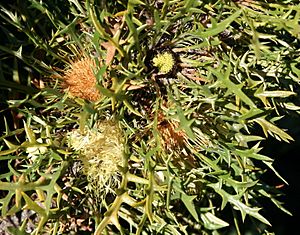Banksia cirsioides facts for kids
Quick facts for kids Banksia cirsioides |
|
|---|---|
 |
|
| Banksia cirsioides at Fitzgerald River National Park | |
| Scientific classification | |
| Genus: |
Banksia
|
| Species: |
cirsioides
|
| Synonyms | |
|
|
The Banksia cirsioides is a type of shrub that grows only in Western Australia. This means it is endemic to that area. It has special leaves that are deeply cut, almost like feathers. These leaves have six to ten pointy parts on each side. The plant also has fuzzy flower heads with pretty yellow and pink flowers.
About This Plant
The Banksia cirsioides is usually a round or tall, column-shaped shrub. It can grow up to 2 meters (about 6.5 feet) tall. This plant does not have a special woody swelling at its base called a lignotuber. A lignotuber helps some plants regrow after a fire.
Leaves and Flowers
The leaves of this banksia are hairy and deeply divided. They are about 60 to 105 millimeters (2.4 to 4.1 inches) long and 20 to 45 millimeters (0.8 to 1.8 inches) wide. Each leaf sits on a small stalk, called a petiole, which is 6 to 10 millimeters (0.2 to 0.4 inches) long. Each side of the leaf has six to ten sharp, narrow, or spear-shaped parts.
The flowers grow in a head, with about 100 to 120 flowers in each head. At the bottom of the flower head, there are hairy, narrow, or spear-shaped special leaves called involucral bracts. These can be up to 25 millimeters (1 inch) long. The flowers themselves are yellow with a pink base. The main flower parts, called the perianth, are 29 to 34 millimeters (1.1 to 1.3 inches) long. The female part of the flower, called the pistil, is light yellow and 32 to 42 millimeters (1.3 to 1.7 inches) long.
When It Blooms
This plant usually blooms from May to August. After flowering, it produces a fruit called a follicle. This fruit is mostly smooth and is 7 to 11 millimeters (0.3 to 0.4 inches) long.
How It Got Its Name
This plant was first officially described in 1856 by a scientist named Carl Meissner. He named it Dryandra cirsioides. He wrote about it in a large plant book called Prodromus Systematis Naturalis Regni Vegetabilis. The plants he studied were collected by another botanist, James Drummond.
The second part of its scientific name, cirsioides, means it looks similar to plants in the genus Cirsium. These are often known as thistles. Later, in 2007, two scientists, Austin Mast and Kevin Thiele, moved all plants from the Dryandra genus into the Banksia genus. This is why its name changed to Banksia cirsioides.
Where It Lives
The Banksia cirsioides grows in a type of shrubland called kwongan. You can find it in Western Australia, between the Stirling Range and Munglinup. It grows in several different natural areas, including the Avon Wheatbelt, Coolgardie, Esperance Plains, and Mallee biogeographic regions.

